Artists have long been preoccupied with the problem of how to represent visual experience. It is often claimed that the problem was solved, in principle at least, by the discovery of linear perspective, which is based on well-understood principles of geometry and the behaviour of light.1 From the mid-fifteenth century the theory of linear perspective gradually began to dominate the representation of visual space in European art and paved the way for most of the imaging technologies used today. Yet even through the early phase of its adoption, and on several occasions since, discrepancies have been noted between geometrical representations of space and the way we actually perceive it.2
During the twentieth century a number of British artists looked afresh at the question of how to depict visual perception and came up with novel answers. Resisting the weight of a pictorial tradition based on the logic of linear perspective, they began to record properties of vision rarely ever recorded before. Many of the works produced as a result of these experiments remain obscure, and little attempt has been made to analyse their content or locate them in their art historical context. One reason, perhaps, is that it is not easy to see what these artists achieved without sufficient knowledge of visual perception and without direct experience of trying to depict it.
It is relevant to what follows that one of the authors, Robert Pepperell, is an artist who has studied visual perception and how it can be depicted in drawing, painting and photography.3 In the course of this study he noticed features in paintings by twentieth-century British artists that appeared in his own attempts to record visual experience. These included differential renderings of the central and peripheral visual field, views of the body seen from the first person perspective, the subjective curvature of straight lines, binocular ‘double vision’ and unusual spatial proportions. Investigation of relevant archives confirmed that the artists discussed here were indeed experimenting with ways of representing reality ‘as seen’. But in doing so they often found themselves portraying highly subjective features of visual experience over which the laws of linear perspective had little jurisdiction.
This preoccupation with recording what the critic Clive Bell called the ‘facts of vision’4 seems to have been a peculiarly British phenomenon, even if it owed much to the French modernists, especially Paul Cézanne, Pierre Bonnard, Georges Braque and Alberto Giacometti.5 It pervaded the London art establishment, including its most important teaching institutions: Camberwell, Chelsea and in particular the Slade School. Many of the key works and relevant documents are now part of the Tate collection. Painters as diverse as Ivon Hitchens, William Coldstream, Lawrence Gowing, John Bratby, Euan Uglow, Lucien Freud, Richard Hamilton, Anthony Green and David Hockney participated, along with critics and historians such as David Sylvester and Ernst Gombrich.
The story of this radical rethinking of the rules of pictorial representation turns out to be wide ranging and complex. This essay confines the discussion to the work of six artists who made particularly significant contributions: Ivon Hitchens, Evan Walters, William Coldstream, Robert Medley, Lawrence Gowing and Richard Hamilton. In order to fully appreciate their experiments it is necessary to have some background on the theory of linear perspective and the psychology of visual perception.
Linear perspective and visual experience
According to the art historian John White, what made the development of linear perspective during the Renaissance so revolutionary was that for the first time it sought to ‘relate pictorial space to everyday experience of the three-dimensional world’.6 Painters increasingly aspired to simulate visual reality, not just portray imaginary worlds. The crux of the linear perspective method was conveyed by Leon Battista Alberti’s eponymous window analogy, described in his essay of 1435: ‘I draw a rectangle of whatever size I want, which I regard as an open window through which the subject to be painted is seen’.7 For Leonardo da Vinci, ‘perspective is nothing else than seeing a place [or objects] behind a plane of glass, quite transparent, on the surface of which the objects behind that glass are to be drawn’.8 From its inception linear perspective imposed two conditions on picture making: that the represented space should be bounded by a rectangular frame and projected onto a flat surface.9
Linear perspective has overwhelmingly determined the Western tradition of image making; some have argued it has shaped the West’s entire worldview.10 It certainly underpinned the later development of photography, cinema and computer graphics, which with few exceptions produce images that conform to the same conditions.11 But this method of representing the three-dimensional world on a flat plane had practical limitations, as Leonardo and others recognised.12 In fact, linear perspective is surprisingly inadequate as a method of recording what can actually be seen, for several reasons.
The human binocular visual field extends some 180 degrees laterally and 130 horizontally.13 But linear perspective is incapable of depicting such wide fields of view. Because it projects three-dimensional space onto a flat plane, anything too far from the central line of sight or too close to the viewing station becomes ‘monstrously’ distorted.14 Artists have traditionally been advised, therefore, to restrict their view to between thirty and sixty lateral degrees – much less than the full range of visible space – and to avoid extremely close objects.15 For painters, the rectangular window frame conveniently obscured the geometrically awkward extremities of the visual field, as it was also to do later for photographers, cinematographers and creators of computer images. The result has been that for hundreds of years depictions of visual space have been confined to a narrow aperture that excludes most of what can be seen. Only rarely has this convention been challenged.16
Aside from the geometric problems of depicting wide angles of view, artists have had to contend with the fact that the majority of what can be seen at any one time is quite indistinct. The central area of vision coincides with a part of the retina that is richly populated with rod and cone nerve cells and served by a large region of the visual brain. Here our vision is most acute. The peripheral areas, which account for the largest portion of the visual field, contain a sparser distribution of rods resulting in poorer acuity and colour discrimination. Most observational painters have disregarded this fundamental property of vision and rendered visual space with more or less uniform clarity and saturation.17
Ignorance of the properties of the peripheral visual field and its exclusion from depicted space have had another, barely noted, consequence. For most of us our own bodies are the one constant feature of a lifetime of visual experience. Although they are usually seen peripherally and indistinctly, our noses, cheeks, torsos, hands and legs frame our visual world, not to mention objects like glasses or hats that are worn in close proximity to the face. Yet this ‘egocentric perspective’ is hardly ever depicted in art.18 As the psychologist James Gibson pointed out in 1950 in his book The Perception of the Visual World (which was to influence Richard Hamilton’s experimental depictions of mobile visual experience),19 our marginal awareness of our own bodies conditions our perceived relationship to the entire world. Gibson wrote, ‘perceiving the environment includes the ego as part of the total process. In order to localise any object there must be a point of reference. An impression of “there” implies an impression of “here”, and neither could exist without the other’.20
Analogies between the camera and the human eye are rarely instructive, and never less so than when the curved retina is compared to the film or sensor, which is invariably flat. Due to the curvature of the retina the light that strikes the eye will have a different geometry than that received by a camera, which operates by the laws of linear perspective and renders straight lines in nature straight in the image.21 As with the examples noted above, this difference will be most noticeable at the periphery of the visual field, which is the part most likely to be cropped by linear perspective’s window frame. Yet, when artists and others have paid close attention to their peripheral visual experience they have noticed that straight lines appear distinctly curved. This observation has led to several theories of curvilinear perspective, which their authors have argued provide a more accurate and natural way of depicting visual reality.22 The pioneering experimental psychologist Hermann von Helmholtz empirically verified the curvature of the visual field in the nineteenth century by showing that a warped checkerboard pattern appears uniform when viewed at close range.23
But the greatest disparity between linear perspective and visual experience rests on the fact that most of us see with two mobile eyes while linear perspective pictures depict a static monocular viewpoint. It is well known that the lateral displacement of the eyes contributes to the stereoscopic perception of depth. But this configuration also gives rise to other properties of vision that are less well known. Physiological diplopia, or ‘double vision’, is a normal property of binocularity caused by the fact that as the eyes converge on an object at one point in space they do not converge on objects immediately behind or in front.24 The effect can easily be seen if one finger is held in front of an object seen with both eyes. The area behind the finger will appear doubled when the finger is in focus, while the finger will double if focus is switched to the area behind. Linear perspective takes no account of this phenomenon, and relies instead on so-called monocular depth cues, such as size diminution, occlusion and shading to convey a sense of depth in the image. Moreover, as the example of the finger shows, in natural vision we are free to examine the objects in a scene at different distances, or move our eyes to another part of the scene, at which point the visual structure changes accordingly. Linear perspective images, being rendered from a fixed viewpoint and oblivious to the dynamics of binocular disparity, focal accommodation and eye movement, do nothing to reflect this freedom.
Even though it deviates from natural vision in many ways, linear perspective has been a remarkably successful method of representing visual space. Its supporters argue that this is because it is the only mathematically and optically correct method.25 Whether or not this is true, it has long been the dominant standard of representational accuracy; the concept of ‘photographic realism’ retains its currency. Yet at various times artists have more or less explicitly rejected its rules in an attempt to render the experience of natural vision. Mentioning no one by name, the critic John Ruskin in Elements of Drawing criticised the attempts of certain mid-nineteenth-century painters to imitate the effects of the then highly fashionable stereoscope using a ‘confusion of lines’.26 This suggests that artists at the time were experimenting with introducing binocular visual cues into their works. Meanwhile J.M.W. Turner, as Professor of Perspective at the Royal Academy in London, was lecturing on the discrepancies between observed phenomena and the theory of linear perspective.27 As a painter, he found it necessary on many occasions to adapt perspectival rules in order to accommodate wide vistas or the expanse of an architectural interior, introducing curvature in a way that strict application of the rules would not permit. The effects can be seen in in mature works, such as Rome, from the Vatican exhibited 1820 (Tate N00503) and Petworth Park: Tillington Church in the Distance c,1828 (Tate N00559).
But perhaps the most decisive break with single-point perspective came with the development of analytic cubism around 1909–10. Of the two artists who initiated the style, Braque was most explicit in denouncing traditional perspective: ‘Scientific perspective is nothing but eye fooling illusionism; it is simply a trick – a bad trick – which makes it impossible for an artist to convey a full experience of space, since it forces the objects in a picture to disappear away from the beholder instead of bringing them within his reach’.28 Cubism, of course, dispensed with the requirement that the picture only records the rays of light directly in line with the static eye of the artist. Braque and Picasso effectively de-centred the viewpoint of the artist, and by extension the viewer, with respect to the depicted scene in order to reveal facets of objects that would otherwise remain occluded. It is within this tradition of occasional artistic resistance to a hegemonic pictorial convention that the experiments of the British artists discussed here can be situated.
Ivon Hitchens and the ‘perspective of space’
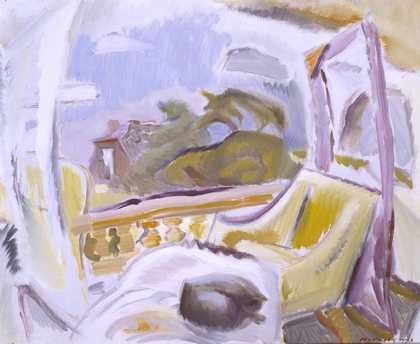
Ivon Hitchens
Balcony at Cambridge (1929)
Tate
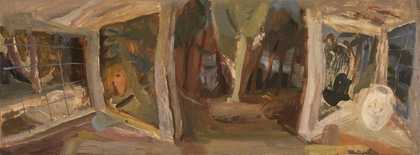
Ivon Hitchens
Winter Stage (1936)
Tate
Like many British artists of his generation, Ivon Hitchens (1893–1979) was deeply affected by French modernism, and by Cézanne and Braque in particular. The lesson Hitchens took from Braque seems to have been the one Braque took from Cézanne: that relentless, disciplined observation of the natural world can feed artistic innovation. Many of Hitchens’s works in the 1920s and 1930s show that he was interrogating his visual sense and discovering new phenomena, in particular the subjective curvature of straight lines, which he reported directly in paintings and drawings. The stylised forms of Curved Barn 1922 (Pallant House Gallery, Chichester) probably owe more to Cézanne and cubism than to direct transcription of visual sensation. But by 1925 he was consistently bending his architectural forms, as is evident in A Border Day (Ashmolean Museum, Oxford) and Cottage Interior (MacConnal-Mason Gallery, London) of that year, while two paintings from 1929, Balcony at Cambridge (Tate T03122; fig.1) and Moatlands Interior (private collection) display pronounced bulging that must have been intended to evoke the approaching space of the respective rooms they depict. The same warping of window frames recurs in Winter Stage 1936 (Tate N04923; fig.2) and Woman Seated at Window 1939 (private collection). Such treatment might appear modernistically mannered were it not that it resulted from sustained visual scrutiny, as John White affirmed:
Ivon Hitchens … told me that as far as he was aware he had never read anything on the subject, but that he had, during a period of prolonged and intense observation, become aware that objectively straight lines did in fact appear to him to be subtly curved, and that such observations formed the basis of these compositions.29
As well as the subjective curvature of straight lines, Hitchens also became profoundly aware of the lateral expansiveness of space when confronted with the landscape. His highly developed visual sensitivity led him to see the environment as composed of multiple views, and he was sometimes left struggling to decide which to paint.30 One solution was to combine several views into a single, elongated picture, which the critic Tom Rosenthal called his ‘Cinemascope’ canvases,31 and for which the curator Alan Bowness claimed Hitchens was indebted to Braque.32 View from Terrace: Ashdown Forest 1938–41 (Tate N05368) is a sweeping, arched panorama encompassing a vast swathe of space. Over four metres long, it represents an angle of view far greater than the sixty degrees recommended by conventional perspective theory. Like most trained artists of his generation, Hitchens would have received instruction in the principles of linear perspective, certainly when studying at the Royal Academy Schools. It was not out of ignorance, therefore, that in his only published theoretical statement, in a 1956 edition of the Royal College of Art journal Ark, Hitchens emphatically denounced the formal method of ‘Perspective’ as incapable of correctly representing the experience of ‘Space’:
The fault of many pictures is that they are painted as happening in the space of Perspective, i.e. created by the perspective, whether linear or tonal. They are not created in the perspective of Space. That is, their space is not a solid reality as it should be: it has no tone or colour relations and therefore has no visual aesthetic value. Accurate perspective may be aesthetically wrong in that it directs the eye to a wrong distance or wrong point in the picture plane. In solid reality – the space between one object and another is of differing proportions, differing in tone and colour and significance.33
Here Hitchens stresses the inadequacy of ‘accurate’ perspective in conveying the ‘solid reality’ of visual experience and implies that there is an aesthetic benefit in getting things on the canvas to fit with the way we see. Although his later works can appear expressively abstract, like the French artists he most admired Hitchens never abandoned the transcription of vision. But he did so in a way that, like Cézanne and Braque, abandoned linear perspective. He developed instead an original painterly language that articulates the lived experience of vision rather than cataloguing the contents of the world.
Evan Walters and the ‘totality of vision’
Born in Wales in the same year as Hitchens, Evan Walters (1893–1951) was a far less well-known contemporary. They were both enrolled at the Royal Academy Schools around 1914 and both lived in Hampstead in the 1920s and 1930s, although no evidence has emerged that they communicated.34 Walters is now obscure, but was successful and widely known during the early phase of his career between the wars, particularly for his depictions of working class Welsh life and society portraits. He was enthusiastically championed by no less a figure than Augustus John who arranged a solo exhibition for him in London, which received wide press coverage.35 John also wrote a flattering article on Walters for American Vogue in 1927 and may have helped him to secure prestigious portrait commissions.36
As a rather conventional social realist and society portraitist Walters might be all but forgotten were it not for a revelation he had one evening in 1936 when relaxing by the fire. He noticed when looking into the flames that his boot, interposed between him and the fire, had the characteristic doubled appearance associated with physiological diplopia, or ‘double vision’.37 The experience alerted Walters not just to double vision, but also to the indistinct properties of the peripheral field.
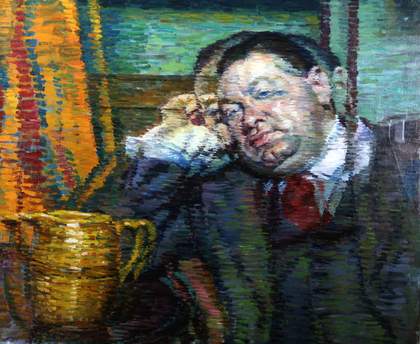
Fig.3
Evan Walters
Stout Man with Jug c.1936
Glynn Vivian Art Gallery, Swansea
© The artist’s estate
The revelation changed Walters’s life and his fortunes, but not necessarily for the better. He immediately began an intensive study of these visual phenomena, and the effects can be seen clearly in Stout Man with Jug c.1936 (fig.3). Here the focus is on the central area, the man’s face, while doubled images flank his nose, which must have been the artist’s point of fixation. Objects are rendered with increasingly large horizontal brush strokes as the painting approaches the edges in an evocation of the relative indistinctness of the peripheral visual field. Within a short time he had produced a substantial body of work, which was exhibited in London in 1936. Again it received wide attention; his ‘double vision’ method was featured in a Pathé newsreel in early 1937, which would have circulated nationally. But the show was a commercial disaster. None of the works sold, and although Walters pursued his visual researches for the rest of his life, he did so in the face of increasing indifference from collectors and critics.38
Besides the many paintings scattered throughout museums and private collections that record Walters’s tenacious struggle to capture what he called the ‘totality of vision’, a number of writings detailing his motives and methods have, fortunately, survived. He published a series of articles in 1940 for the popular magazine the Artist (all titled ‘Vision and the Artist’),39 which were a distillation of a longer manuscript he had prepared on his ideas, which remains unpublished.40 It is also fortunate that his partner in later life, Erna Meinel, was a persistent and articulate advocate, and continued to preserve and disseminate his work long after his death.41 Walters’s own writings and an article and unpublished manuscript by Meinel reveal a well-informed understanding of visual perception that underpins a detailed theory of artistic depiction. Both Walters and Meinel were clear about the historical significance of Walters’s discovery. In his words: ‘in vision itself little advancement has been made since the adoption of perspective by artists some centuries ago. Consequently all pictures in existence, without exception, are painted as though their creators had only one eye in their heads, similar to a Cyclops’.42

Fig.4
Evan Walters
Still Life with Cricket Ball 1940
Glynn Vivian Art Gallery, Swansea
© The artist’s estate
Even if he overstated his case, he was broadly right. With the possible exceptions of Cézanne 43 (whose example Walters came to admire), Bonnard44 and Giacometti,45 very few artists had even tried, let alone found a successful way to represent the binocular aspects of visual experience in a two-dimensional image.46 Not only had Walters done this with some success, he had also tackled the complex and elusive contents of the peripheral visual field, and his obsession with conveying the actuality of visual experience even led him to include his own semi-transparent nose in various compositions of the 1940s, such as Still Life with Cricket Ball 1940 (fig.4). Other than the illustration of the view of his own body used by Ernst Mach in Analysis of Sensations of 1897, this seems to have been an unprecedented artistic act, and almost completely revoked the pictorial conventions imposed five centuries earlier by Alberti’s window metaphor.
In the same year that Walters had his fireside revelation he also visited the London International Surrealist Exhibition, an experience that may have contributed to his artistic crisis. René Magritte’s Treachery of Images 1928–9 was not included in the exhibition catalogue but was already widely known, and Walters may have had it in mind when he wrote in the catalogue for his show: ‘you can paint one pipe and two backgrounds if you like, or one background and two pipes, but it must be one or the other, or you have not painted what you actually saw. It is not a theory of painting, but it is a physical act of vision’.47
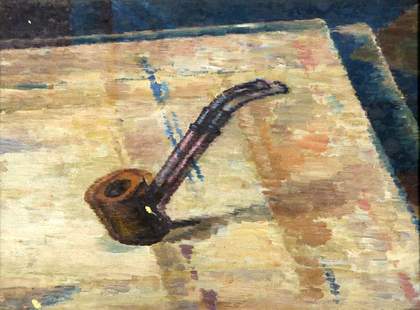
Fig.5
Evan Walters
Pipe c.1936
Glynn Vivian Art Gallery, Swansea
© The artist’s estate
Walters did paint a pipe (fig.5), suitably doubled as it would appear to a two-eyed viewer looking slightly beyond it, and such images could be seen as his own attempt to enter the fray of European modernism from which his provincial style had until then excluded him. Certainly he later made works in a modernist manner, with abbreviated, alien-like figures wandering in strange duplicated worlds. Perhaps he was searching for a way to make his discoveries relevant to his artistic age. Sadly, he realised shortly before his death that he had probably failed. In a brief and poignant article entitled ‘The Decline in Artistic Taste’, published in 1948, he defiantly restated his case: ‘if only painters would use both eyes at once, they would not be tempted to distort in order to avoid resemblance to photography’.48 But by then he could see little sign that contemporary artists, or indeed anyone else, were responding to his call.
William Coldstream and the ‘exploitation of vision’
William Coldstream (1908–1997) occupies a central place in the story of modern British art’s preoccupation with recording visual sensation. Early in his career he had flirted with non-figuration and was involved with the Objective Abstractions group, which included Geoffrey Tibble, Rodrigo Moynihan and Graham Bell.49 A show by the group in 1934 included work by Hitchens. But Coldstream soon rejected the abstractionists’ stress on the objective materiality of their work, coming to the conclusion that ‘painting is the exploitation of vision, not of material’.50 It was at the Euston Road School, which he helped to found in 1938, where he seems to have refined his eponymous and laborious method of observation and spatial measurement, ironically termed the ‘Camberwell Easy’ by students at that art school who were later subjected to its rigours.51 Several contemporary accounts record Coldstream’s method being applied or taught, and the impact it had on students, which was by no means always beneficial. It involved the use of a pencil or brush held at arm’s length along which the thumb was moved to mark off proportions on the model while the artist squinted with one eye to gauge the distances. These measurements were meticulously transferred to the canvas or paper to form a grid of coordinates corresponding to key points in the observed scene.52
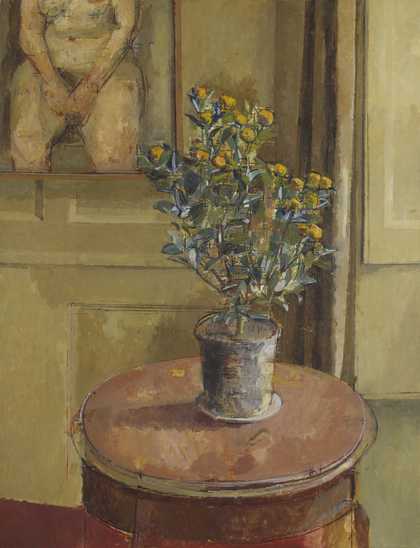
Sir William Coldstream
Orange Tree I (1974–5)
Tate
© The estate of Sir William Coldstream. All Rights Reserved 2023 / Bridgeman Images
Coldstream’s method has often been criticised for being excessively prescriptive and conservative. But this belies the more radical implications of his approach. The traditional rules of perspective assume a fixed viewing position within the scene, with the line of sight leading to a distant vanishing point. Space radiates out from the centre of the depicted field of view, as is apparent in any picture constructed according to the principles of Alberti’s window or Leonardo’s plane of glass. Coldstream’s pictures are constructed in a quite a different way. Christopher Pinsent, one of his former students, noted that Coldstream’s technique requires the measuring arm to be fully extended at all times, whatever part of the scene is observed. This results in a curved plane that sweeps around the artist, with its centre point at his or her rotating eye.53 The picture, therefore, is built up using a form of geometry quite different from traditional perspective. It is, in effect, a novel form of curvilinear perspective, which in theory at least is a more veridical recording of what the eye sees as it scans the three-dimensional space ahead. 54 Coldstream’s picture space is not the equivalent of a flat window through which we peer, but a carefully plotted map of a hemispherical slice of the world. The pictorial consequences are evident in the nudes and still lives of the 1960s and 1970s, which often show a subtle curvature of space, as can be seen, for example, in the bed in Reclining Nude 1976–7 (private collection) and Orange Tree I 1974–5 (Tate T06513; fig.6). The latter provides a rotating view of the table, the pot, and the plant as Coldstream’s eye tilts through the vertical plane, causing the lines of the wooden panels behind to gently bend.
Coldtream’s method ultimately failed, however, in the same way linear perspective fails, because it is impossible to reconcile the discrepancies between the curved observational space and the flat canvas, particularly the further one strays into the periphery of visual space. The limits of objectivity were recognised by Coldstream himself:
Of course it doesn’t make sense, because in any ordinary projection … you can’t really use central perspective, for instance, in measuring like that. I mean, if you’re sitting seven or eight feet away from the model you have a different picture plane when you’re looking at the forehead from that in which you’re looking at the knee. Because you look up or down, you don’t look straight forward, so the thing doesn’t really join up. It doesn’t really make any sense.55
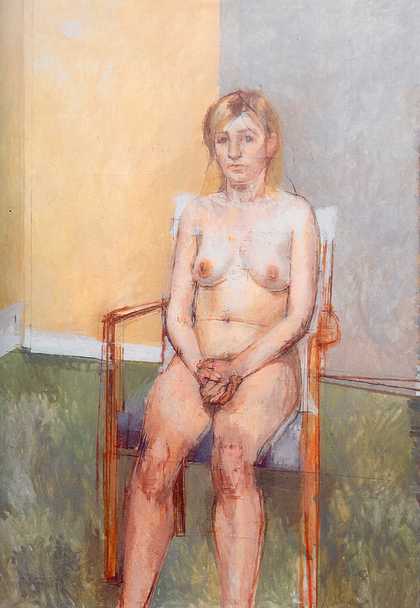
Fig.7
William Coldstream
Seated Nude 1972–3
Private collection
© The estate of Sir William Coldstream/ Bridgeman Art Library
Seated Nude 1972–3 (fig.7) shows a degree of peripheral indistinctness that may be an honest reflection of this inability to accurately measure the more eccentric parts of the scene. The nested vertical lines, especially in the arms of the chair, also indicate uncertain visual data. But Coldstream would have certainly been aware by this time of similar effects generated by his close colleague Lawrence Gowing’s experiments with recording double vision, discussed below, and may have been acknowledging their presence in his own visual field.56
Coldstream’s uncompromisingly objective approach was to profoundly influence generations of students and colleagues, many of whom would wrestle with similar problems and find different solutions. Patrick George’s Waterloo Station from a Window c.1947 (private collection),57 for example, resorts to bending the picture space, much as Hitchens had done, and Euan Uglow’s Nude, 12 Vertical Positions from the Eye 1972 (Victoria Gallery, Liverpool) used a rigorous, mechanical method of measurement to record and synthesise several viewing positions.58
Widely revered as an artist in his lifetime, Coldstream’s reputation has waned since his death. It has been suggested that his paintings are neither the ‘hard won products of some pre-ordained, idealistic scheme of trapping reality’, as is sometimes claimed, nor the ‘English answer to the tricky impasse reached by a rejection of European modernism’.59 In the context of the colourful and turbulent history of art in the twentieth century they can often appear drab and parochial. But seen in the longer time frame of European art since the mid-fifteenth century, with its fascination for capturing visual experience, his attempt to help prise apart the confining logic imposed by Alberti’s window remains significant.
Robert Medley and the ‘visually perceived’
Whatever Coldstream’s reputation as a painter, there can be little doubt about his importance as an educator and his role in directing the attention of several generations of British artists to the problems of depicting visual experience. It was in his capacity as head of the Camberwell School from 1945–9 and then as Slade Professor, University College London, from 1949–75 that his influence was most deeply and widely felt. At the Slade he was able to draw around him a community of staff and students who did not necessarily subscribe to his methods but seemed to have respected his judgment and benefitted from his association.
One such figure was Robert Medley (1905–1994), appointed by Coldstream in 1951 to teach theatre design at the Slade. Medley had been known to Coldstream since before the war when they were both involved in the Artists International Association and Medley had been making socialist realist work.60 Around the time he arrived at the Slade, Medley was undergoing his own artistic crisis of conscience. He acknowledged that Coldstream’s method was useful for him, if also challenging, because it helped him to ‘reconcile in a painting the imaginative with the visually perceived – i.e. what I thought with what I saw’.61 But he also later rejected the ‘literal academicism of the Coldstream School’, partly because for its adherents ‘the emphatic concentration upon measurable appearance – that which was visually perceptible – meant that they stayed permanently outside their subjects’.62 While many at the time were becoming critical of, or even hostile to, Coldstream’s method of capturing the observed world, they were also aware that they had to find a viable alternative.

Robert Medley
The Antique Room at the Slade: Niobe and Hermes (1952)
Tate
Medley’s response can be seen in a remarkable still life, executed in 1952, The Antique Room at the Slade: Niobe and Hermes (Tate T00498; fig.8). For him the painting represented an intuitive and direct approach to capturing the immediate world around him. It also permits two intrusions from the extra-pictorial space occupied by the artist into the depicted space of the room. On the right Medley’s own arm can be seen, bent at the wrist as though in a Coldstreamian act of measurement, and above it what are probably the outer edges of his steel rimmed spectacles as they might have appeared in the periphery of his visual field.63 Again, the inclusion of such features is almost unprecedented in the history of art, and it seems a shame that Medley did not develop this line of pictorial inquiry in subsequent works.64
Lawrence Gowing and ‘shifting binocular vision’
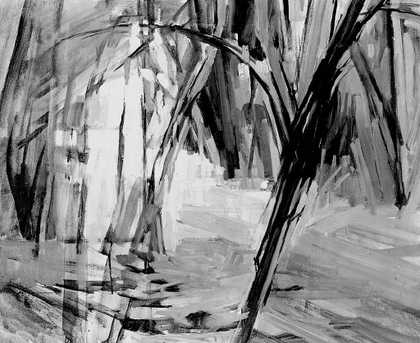
Sir Lawrence Gowing
Path with Elder and Hazel (1959)
Tate
Like Medley, Lawrence Gowing (1918–1991) was closely associated with Coldstream, enrolling at the Euston Road School in 1938 and succeeded him as Professor at the Slade in 1975. Like Coldstream, Gowing devoted much of his energy to teaching, including at Camberwell, Newcastle, Leeds and Chelsea, which alongside being a prolific art critic and historian, writing notably on Cézanne, left relatively little time to pursue the problems of painting. For Gowing, these problems were primarily visual in nature, and became especially acute in the summer of 1959, when, as he wrote: ‘the character of visual information in itself occupied me as it never had before.’65 Painting in Lambourn woods in Berkshire, he became aware of the ‘lateral movement of binocular vision’ and the way vertical edges appeared to multiply.66 He recorded these diplopic sensations as honestly as he could in a series of landscapes, one of which, Path with Elder and Hazel, is now in the Tate collection(Tate T00475; fig.9).67 It presents vibrating trunks and branches rendered semi-transparent by multiple lines, not dissimilar to the effects seen in late Cézanne watercolours.68
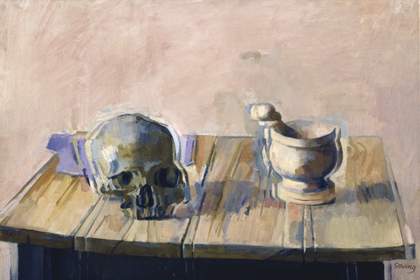
Fig.10
Lawrence Gowing
Still Life: Vanitas 1965
Royal Academy of Arts, London
© Royal Academy of Arts
Gowing continued to investigate ‘recording sensations without construing them’ into the early 1960s.69 A self-portrait of 1963, now in the Ruth Borchard collection, depicts the artist’s face visible in the midst of peripheral ‘shifting contours’, with his left eye as the locus of fixation.70 But it was around 1965 that his interest in depicting binocular vision peaked. He undertook two still life paintings designed to test ‘systematically and directly’71 whether the ‘data of two eyes’ could be represented in a painting.72 One of these appears to be lost but the other, Still Life: Vanitas (fig.10), is now in the collection of the Royal Academy having been offered by Gowing in 1979 as his diploma work.73 With a distinctly Cézannian palette it shows a skull and mortar and pestle on a rustic wooden table, with the main outlines doubled to portray the optical effect of laterally arranged eyes. Ernst Gombrich, with whom Gowing debated questions about art and visual perception, later cited the picture in his essay ‘The Mirror and the Map’ as an example of an artist ‘carrying the impressionist programme to the extreme’ in which the ‘chase after appearances’ can lead the artist to confuse what the eyes register with what we actually perceive.74
It is possible that Evan Walters posthumously precipitated Gowing’s experimental recordings of binocularity at this time. In 1964, Francis Hoyland, then a painting tutor at Chelsea School of Art, gave a radio broadcast on the topic of Giacometti’s painting Seated Man 1949 (Tate N05909), which was reprinted in the Listener magazine.75 Hoyland’s discussion of the spatial properties of Seated Man prompted Erna Meinel to write to him, in April 1964, giving an explanation of the theory of double vision, which she suggested could account for Giacometti’s handling of space in the picture. She also enclosed a reproduction of Still Life with Cricket Ball (fig.4), a study of objects on a table by Walters, as an example of an artist employing double vision to capture binocular depth. According to Hoyland’s reply to Meinel in May 1964 he passed on the letter and photograph to his then ‘boss’ at Chelsea, Lawrence Gowing, whom he said was ‘interested in this sort of thing’.76 There is little doubt that Gowing would have appreciated the affinity between Walters’s still life and the binocular effects in his own recent landscapes, and therefore may have been spurred to embark on Still Life: Vanitas.
The paintings made during the early 1960s, which were included in a one-man show at Marlborough Fine Art in 1965, seem to have presented Gowing with an artistic and intellectual dilemma. Partly out of loyalty to Coldstream, he felt compelled to objectively report the scene before him. At the same time, true objectivity demanded that he record the reality of his subjective visual sensations. In a note made during this period he wrote: ‘I can’t get on without the positiveness that Coldstream taught me, but I want to be positive about the information of shifting binocular vision’.77 He later became bored by the mechanics of meticulously objective painting for he seems to have abandoned these visual researches soon after painting Still Life: Vanitas. With the exception of a striking portrait of Tate’s former director, Sir Norman Reid (Tate T03208), made in 1988 and inspired in part by seeing his own reflection in a broken mirror, there are no examples of such experimentation in his subsequent work.78
Richard Hamilton and ‘the visual phenomenon of motion perspective’
Richard Hamilton (1922–2011) joined the teaching staff at Kings College, University of Durham, Newcastle-upon-Tyne in 1953, at a time when he was researching novel ways of depicting visual experience, a project begun in preceding years as a student at the Slade. Gowing was then Professor at Newcastle, and it may be that he had Hamilton in mind when he spoke of the ‘disturbing and contradictory innovations’ of his colleagues which, by Gowing’s own account, contributed to his ‘impatience with visual painting’ and may well have stimulated the new direction his work took in 1959.79
Hamilton had studied at the Royal Academy Schools from 1938 to 1940, and received a thorough training in classical perspective theory, probably very similar to that offered to Hitchens and Walters some thirty years before.80 Following an apprenticeship in technical drawing, he spent the years 1948–51 at the Slade studying with Coldstream, where he said ‘the atmosphere was marvellous’.81 He devoted much of his time there to life drawing, no doubt applying the semi-mandatory Coldstream measurement method, and like many of his contemporaries was drawn to the example of Cézanne. A series of paintings made in 1950 took as their starting point Cézanne’s method of ‘structuring the surface through straight linear relationships’.82 Hamilton later noted with some satisfaction the evident ambiguity between the illusory perspectival depth implied by diagonal lines and the flatness of the marks and canvas.83 The power of perspective to manipulate visual perception clearly fascinated him – he later referred to the demonstrations of the technique he witnessed as a student at the Royal Academy as ‘magical’.84 But he also felt it was a fascination that put him to some extent at odds with his contemporaries: ‘having an unfashionable (at that time) predisposition towards an illusory representational space it was likely that perspective would form a major part of my student interests’.85

Fig.11
Richard Hamilton
Study for Re Nude 1954
British Museum, London
© The estate of Richard Hamilton
© The Trustees of the British Museum
Exposure as a student to the writings of the psychologist J.J. Gibson, whose book The Perception of the Visual World Hamilton described as ‘wonderful’, sensitised him to the role of motion in spatial perception, something that classical perspective was unable to describe.86 Gibson’s work with military pilots during the Second World War had led him to develop a ground breaking theory of visual perception in which our awareness of space arises through the way we dynamically interact with forms and textures in the world. This proved to be a fertile insight for Hamilton, and informed an extended period of research into vision and motion, culminating in a key figure painting, Re Nude 1954 (Moderna Museet Stockholm), a preparatory study for which can be seen in fig.11. These and other paintings and prints of still life subjects made at the time superficially resemble Walters’s and Gowing’s double vision images. But while they share the intent to render the subjective properties of vision not catered for by fixed and monocular perspective, the works of this period achieve this end in a different way. In Re Nude, Hamilton posed a (theoretically) static model, and depicted her from three different positions, each slightly closer to the model than before. In this way he hoped to mobilise the ‘rigidly locked eyeball’ and bring about something closer to the way we actually see in everyday life.87 These works clearly owe a lot to the nineteenth-century photographer Eadward Muybridge, and Hamilton described them as essentially futurist in conception.88 Where his figure and still life works of this period differ from their historical precursors, however, is that rather than capturing a moving object from a fixed viewpoint (even if it is a series of static cameras, as in the case of Muybridge) they capture a fixed object from a moving viewpoint.
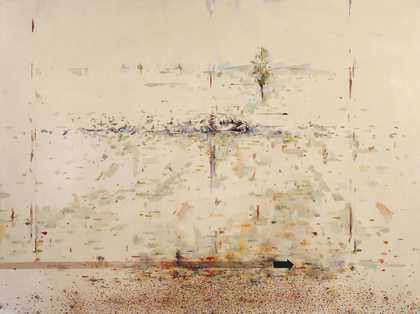
Richard Hamilton
Trainsition IIII (1954)
Tate
This novel approach was further developed in another series made around the same time. On his frequent train journeys between London and Newcastle-upon-Tyne, Hamilton scrutinised the flow of space between him and the passing landscape. This led to the Trainsition series of 1954, which are quasi-diagrammatic paintings of the way a spectator visually grasps static objects in the moving world beyond. They owe much to Cézanne’s late watercolours in terms of their luminosity and the tentative touches used to describe form. Trainsition IIII (Tate T01201; fig.12) shows a static tree – the point of visual fixation – surrounded by a dynamically shifting landscape. Trainsition III (private collection) shows an identical tree, but this time at closer range and distinctly doubled. Of these paintings Hamilton wrote:
A landscape, Trainsition, took a particular visual phenomenon of motion perspective, the apparent rotation of a visual field around a point of focus when the eye is moving significantly in relation to a space. In a mobile situation, the only fixed point, that is to say visually static in relation to the other forms and locations, is the point that the observer focuses on at any one moment; change focus to another position, closer or further away, and the direction of movement of objects and surfaces in front of and behind relates to that new visual fulcrum.89
This is a perceptive and perceptually accurate description of the way our eyes interact with the world, and it is believed that the associated paintings are the first to depict this fundamental property of everyday vision.
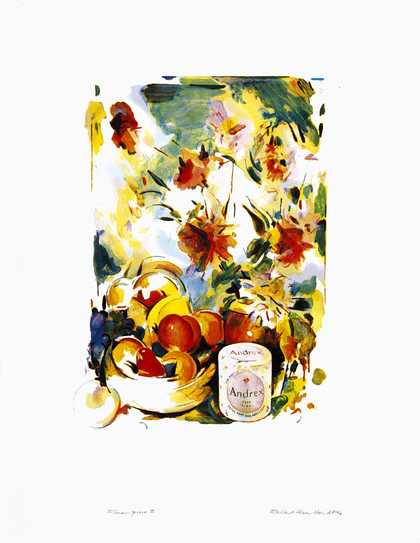
Richard Hamilton
Flower-piece B (1975)
Tate
Hamilton’s studies of the perception of space and motion have often been read in light of his subsequent interest in the work of Marcel Duchamp and modern culture, that is, as art historical allusions or celebrations of speed and technology.90 But such readings risk obscuring one of Hamilton’s major accomplishments, which was to redefine the established rules of spatial depiction, rules that he knew intimately and respected. While Hamilton’s researches in visual perception came to a somewhat abrupt halt in 1956, the year he began to engage earnestly with consumer culture, he would return at various times in his career to explicitly visual themes. The flower prints of the 1970s, for example, were inspired by lenticular three-dimensional postcards, and several, such as Flower-piece B 1975 (Tate P12106; fig.13) feature a clearly rendered object – the toilet paper – amid a peripheral riot of multi-edged plants that resemble in their handling the still life double vision images of his former colleague Lawrence Gowing from the decade before. Paintings such as Soft Blue Landscape 1976–80 (private collection) have been read as evocations of properties of visual perception and the artifice by which it is represented; in this case a central area of clarity dissolves into uncertain abstraction with increasing eccentricity in precisely the same way it does in actual visual experience.91
‘A British style’
Most of the works discussed in this paper are infrequently exhibited and feature rarely, if at all, in surveys of British painting. Walters faded into obscurity after his death, his innovations having had virtually no impact on subsequent artists. The fate of Gowing’s large body of binocular paintings was not glorious, and he moved on to other artistic adventures.92 And Hamilton’s early and indeed prolonged fascination with novel forms of perspective is eclipsed by his reputation as the ‘founding figure of Pop art’.93 It may be tempting, therefore, to dismiss these artistic experiments as no more than minor curiosities in the larger sweep of British modern art. However, it has been the intention of this paper to argue that something closer to the opposite is true: that the history of modern British painting cannot be understood without appreciating the ways in which key artists tackled the problems of depicting visual experience, and the historically important innovations that resulted.
Beside those already discussed, there are many other significant figures for whom textual and visual evidence exists to suggest that they were motivated by similar concerns, including Francis Bacon, David Bomberg, John Bratby, Andrew Forge, Lucien Freud, Patrick George, Anthony Green, Timothy Hyman, David Hockney, Francis Hoyland, Walter Sickert, Euan Uglow and John Wonnacott; in other words, many of the leading twentieth-century British painters.94 So the question arises, what was going on in this country at this time that so attracted these artists to this issue?
It is of course a mistake to reach for simple or narrow causes to account for complex phenomena. But in seeking to understand these pictorial innovations it is useful to reflect on some of the wider social and historical factors that motivated them. These are arguably threefold: artistic, political, and philosophical.
In the early part of the twentieth century Paris set the artistic pace for Britain. The impact of French modernism on those working in London and elsewhere during the period is well known. But it is hard to overstate the extent to which Cézanne in particular, and later Braque, Bonnard and Giacometti, would serve as touchstones for the artists considered here. Despite their stylistic differences, what those working in France did, and what so stimulated their British contemporaries, was to make the process of perception a primary subject of their art. 95 In doing so they exposed the limitations of the conventions of classical perspective, which was only ever designed to plot a cone of light. Cubism finally dispensed with these conventions, and artists thereafter struggled to find new ways to express the ephemerality and mutability of perceptual experience, for which there was no formal pre-given language. British artists of this period not only benefitted from the example of their French predecessors in this regard but also substantially contributed to the palette of visual experiences that could be depicted, as has been shown.
Given the economic and geopolitical turbulence of the time, the question of how artists should discharge their political responsibilities became paramount for artists in pre-war Britain, and in this regard the question of realism assumed central importance. In the 1930s Coldstream and his colleague Graham Bell were committed to an uncompromising objectivity in painting that they hoped would serve a mass working class audience who they believed had been alienated by the ‘lyrical realism’ of artists with more surrealistic tendencies.96 Reflecting later in life on his experiences in the 1930s, Coldstream said: ‘the slump had made me aware of social problems, and I became convinced that art ought to be delivered to a wider public … It seemed to me important that the broken communications between the artist and the public should be built up again and that this most probably implied a movement towards realism’.97 This outlook had already led Coldstream to briefly abandon painting in favour of what he held to be the more widely accessible medium of film; in 1934 he worked with John Grierson at the General Post Office Film Unit making socially progressive documentaries.
In 1938 Coldstream and Bell were invited to contribute to Mass Observation, a social experiment that aimed to record the lives of ordinary people through interviews and visual documentation. They were among several artists who were asked to paint Bolton in order that the resulting works could be exhibited in the town to gather the opinions of residents. For Bell and Coldstream this presented an opportunity for closer engagement with the kind of real world conditions they believed other forms of contemporary art eschewed. As Bell put it: ‘1) The Boltonians are not interested in art; 2) but they are interested in Bolton’.98 It turned out that popular opinion deemed Coldstream’s townscape (a view from the roof of Bolton Art Gallery) somewhat drab, featuring too many chimneys and lacking living figures.99 Coldstream and Bell also contributed to a key debate organised in 1938 by Robert Medley under the auspices of the Artists International Association, which was formed to mobilise art and artists against fascism and the threat of world war. The debate pitched advocates of realism (Coldstream, Bell and the Hungarian sculptor Peter Peri) against the surrealists (Julian Trevelyan, Humphrey Jennings of Mass Observation, and Roland Penrose).100 Little is known about the content of the debate, but by all accounts Coldstream and Bell put the case for realism ineffectually.101
As art historian Andrew Causey noted in his essay ‘The Possibilities of British Realism’, during the war Coldstream continued on the path of objectivity he had taken in the 1930s by painting bomb-ruined London, and also served as an official war artist overseas, but that ‘his influence was confined to a relatively small circle of artists’.102 Given the strictures of wartime life, realism in its most austere form did not appeal to a population facing geopolitical turmoil, and sentiment shifted in favour of the picturesque and patriotic. But debates about the nature of realism among the avant-garde in British art resurfaced in the 1950s. As art historian James Hyman explained in The Battle for Realism (2001), the key drivers were the critics John Berger and David Sylvester, each of who championed a different approach to realism grounded in divergent beliefs about the political function of art.103 For Berger, the job of the artist was to reflect the conditions of real life, and through doing so reveal fundamental truths about the world and, in particular, the structure of society.104 Sylvester, on the other hand, stressed the reality of the individual’s visceral experience, exemplified by the art of Francis Bacon, and in particular Bacon’s capacity to manifest subjective attributes of the human condition in paint. In doing so, Sylvester drew on the post-war intellectual milieu of Paris, with which he was in intimate contact.
The third factor driving artists’ preoccupation with the reality of visual perception was the philosophical ambience of Britain in the early to mid-twentieth century. The prevailing mood had been set by British empiricism, a deeply rooted doctrine that the surest form of knowledge is that derived from experience, and in particular sensory experience. By the 1920s and 1930s this tradition had spawned the various schools of logical empiricism, positivism, and logical positivism, with prominent advocates including Bertrand Russell, Ludwig Wittgenstein and A.J. Ayer. These thinkers held that logic could clarify knowledge, thereby endowing it with a degree of scientific objectivity. Something of this must have seeped into Coldstream, and encouraged his tendency for rigorous objectivity in visual art. It is known that Ayer, who held a chair at University College London, regularly conversed with Coldstream and others at the Slade in the 1950s,105 and Richard Hamilton reported that Ayer discussed logical positivism with members of the Independent Group around the same time.106
In Parisian philosophical circles, meanwhile, phenomenology had become a potent intellectual force, mainly through the work of Maurice Merleau-Ponty, whose Phenomenology of Perception was first published in 1945. Art historian Brendan Prendeville has made the case that the contemporary writings of David Sylvester were imbued if not with the letter then the spirit of Merleau-Ponty’s programme.107 Sylvester was an important conduit for transmitting the latest French art and thinking to Britain. He was a prodigious writer on, among others, Bacon and Giacometti, an intimate friend of many artists, and occasional lecturer at the Slade. In the late 1940s he published in Les Temps Moderne, an existential monthly journal edited by Merleau-Ponty and Jean-Paul Sartre. While there is no direct reference to Merleau-Ponty’s ideas in the writings or statements of the artists discussed here, the French philosopher’s thinking had clear affinities with the artistic developments occurring in Britain at the time.
In a series of radio broadcasts given in 1948, later published as The World of Perception, Merleau-Ponty decried the conventions of linear perspective for producing pictures that depart from lived experience. Drawing heavily on the example of Cézanne, he argued that our experience is not of a world observed from afar but one of which we are a part, as earth-bound, embodied, perceiving beings: ‘rather than a mind and a body, man is a mind with a body, a body who can only get to the truth of things because its body is, as it were, embedded in those things’.108 In calling for art to ‘recapture the feel of perceptual experience itself’ he recast the debates about realism and subjectivism that had informed thinking in British art since the 1930s.109 For Merleau-Ponty, the locus of the real is not the external world itself but the world as revealed in perception: ‘It befits our human dignity to entrust ourselves to the intellect, which alone can reveal to us the reality of the world.’110
Prendeville has argued that although Sylvester claimed not to have read Merleau-Ponty until much later, he would nevertheless have been affected by this current of thought. In a lecture Sylvester gave at the Royal College of Art in 1951, titled ‘Towards a New Realism’, he called for artists to ‘map man’s subjective world’ and make images ‘in which the observer participates, images whose space makes sense only in relation to the position in it occupied by an observer’.111 As Prendeville pointed out, this effectively echoes Merleau-Ponty’s programme, and it reflects precisely what certain artists were already doing and others would continue to do in succeeding years, that is, to articulate the embodied visual experience of those who made and looked at them. Writing of the work of his close friend Coldstream in 1962, Gowing had by now reconciled the dilemma he had earlier identified in his own work, which was between loyalty to Coldstream’s single-minded pursuit of visual objectivity and his own honesty about the palpable effects of his senses. He had come to accept that uncompromising objectivity about the visual world entails uncompromising objectivity about vision, which is no less real. As he put it: ‘The visual distinctions that comprise the experience are real things and the distances between them are real and measurable.’112 This sentence aptly sums up what Evan Walters had concluded from his own visual researches some three decades earlier, and encapsulates the transformation that had occurred in British art in terms of what it meant to be realistic: the honest scrutiny originally directed at the social world was gradually redirected, with equal honesty, to the experience of vision itself.
This paper has considered the ways in which a number of British artists looked afresh at how to convey visual experience in paint. The resulting works captured perceptual phenomena that had hardly been painted before, although the debt to French modernism is clear. Artists of this period made works that transgressed the confines of Alberti’s window, thereby expanding the breadth and depth of visual space available for depiction. In doing so they brought the peripheral field, perceptual curvature, and the artist’s own body into the realm of pictorial space. At the same time, the first systematic attempts were made to depict the binocular properties of vision and the dynamic relation between optical fixation and bodily movement. In the long history of human image-making these are significant developments, and deserve greater recognition than they have so far received.
Just before he died in 1951, Evan Walters, who in terms of attending to previously unrepresented features of visual experience was perhaps the most innovative of all the artists discussed here, wrote: ‘I am merely trying, in all sincerity, to introduce a new and natural style – a British style’.113 In fact, by then the fascination with painting the world ‘as seen’ was permeating the highest levels of the British art establishment.

